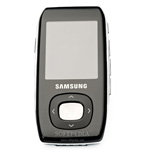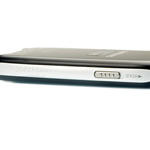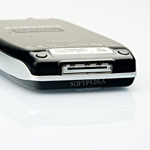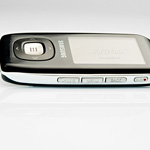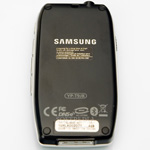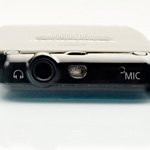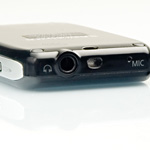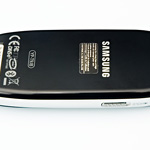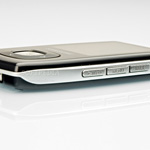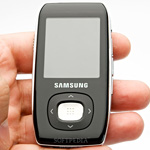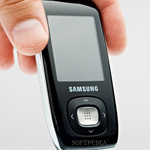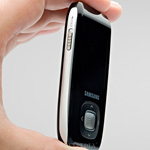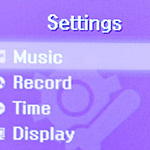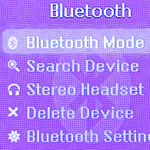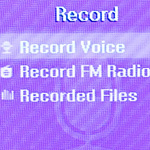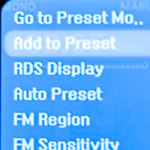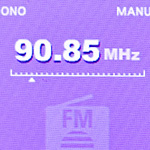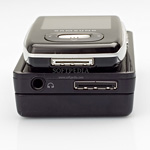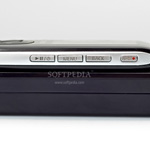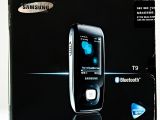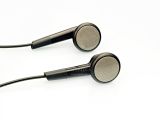The Samsung YP-T9 was announced on November 30, 2006, together with the YP-K5 that was reviewed last week. From design to specifications, the YP-T9 is clearly different from the YP-K5. Probably the most notable differences are the lack of a built-in speaker, the TFT LCD solution instead of the OLED found in the K5 and the presence of Bluetooth.
Our copy had 4GB of internal memory, so we will be referring to this one; however, there are no differences between the 2GB version and the 4GB one. So let's see what are the player's strongest and weakest points and how it compares to other similar units and what our Roxana Deduleasa has to say about it.
Chapter 1 ? The basics
By Alexandru Vochin
Overall design features
The first striking design feature of the Samsung YP-T9 is its size. The player is quite small and slim, even smaller than the iPod?s own slimmest, the Nano model. However, despite its minute size, the device sports a very large display, capable of delivering high-quality, crisp images.
Thus, the display will allow users to see very clearly what they?re doing, whether we?re talking about browsing the playlists, viewing photos or even playing some of the built-in Flash games (albeit that won?t be one of the main reasons for purchasing Samsung?s player, since said games are pretty boring).
Nevertheless, in order to use such a big display and also keep the player?s overall size at a minimum, the designers had to make some sacrifices, the most important being in the button placement area, but we?ll talk about that a little bit later.
Getting back to the design, one thing?s for sure: the people from Samsung used the same designers as in the case of their mobile phones, or at least tried to impose a unitary design policy. Thus, the player?s overall design has some pretty visible common points with some of Samsung?s cell phones, and one of the most interesting aspects is the choice of materials. There?s a lot of brushed metal in there, but also a bit of plastic, since the central control button is manufactured entirely out of it. This choice is rather arguable, since it represents a rather uncanny presence in the T9?s overall sleek and metallic look, and the feeling that this button simply doesn?t belong there is enhanced by the fact that the quality of the plastic is not exactly top notch. However, there?s a pretty good reason why this navigation button is made from plastic, and you?ll see that reason as follows.
The YP-T9 has a sturdy brushed aluminum finishing, which makes it extremely sleek, smooth and rather sexy looking, but also brings about a huge problem: that of fingerprints. As most devices that are meant to be shiny and good-looking, Samsung?s player is also quite a magnet for fingerprints, and even more so for those people with some serious sweat problems. This actually explains the choice of plastic for the central control key, since this is probably T9?s most "popular" button, and the rough plastic won?t be affected by the users? sweaty fingers.
The choice of colors is also an interesting one. There?s the already "classical" shiny black color, common to a wide range of handheld devices, but Samsung has also released a purple version (limited to the 2 GB versions). And since the best thing to go with black is a little bit of shiny chrome, the lateral sides of the YP-T9 are made from this material, the color contrast adding its important contribution to the player?s overall attractive look.
Button and slot placement
As mentioned earlier, Samsung?s YP-T9 control system is based on the central selection button. This particular button is placed directly underneath the display, and is meant to help users carry out most navigation tasks. For this purpose, it features the usual navigation arrows, and its size alone is a guarantee that even the people with bulkier fingers won?t have much of a problem operating the device. Moreover, it has some indentations along the rim, which are especially important if the device is used in the dark, granting it a feeling of safety and physical feedback (something quite a lot of users are looking for in a portable device).
However, the same can?t be said about the side buttons. The player sports a couple of buttons on the right-hand side (record, back, menu and play/pause buttons), which are very useful from the functionality point of view, but have a very unfortunate placement and size. They?re very tiny, so some of the users might encounter some pretty serious problems in remembering which button to press and when, and they are also rather high compared to the player?s overall size, which means that they tend to get pressed accidentally.
This can prove to be extremely annoying, especially if the button pressed by accident is "Play", which also happens to double as the YP-T9?s power switch. However, this problem can be overcome with the help of another button, placed on the left side (the hold button), whose purpose is to act as some sort of locking mechanism for the other ones. Overall, the control system is pretty intuitive, but it takes some time getting used to (longer than in the case of other players, that is).
As in the case of the K5, the people from Samsung have decided ? for some strange reason ? to go with a proprietary charging/data transfer connector, placed on the bottom side of the device. It?s quite an unusual choice, especially since most current players on the market use a mini-USB, but this is probably a part of the Korean company?s strategy to attract and hold onto customers.
The top side of the T9 includes the earbud connector, a small lanyard loop, and the device?s built-in microphone. The fact that the earbud connector has been placed right near the microphone seems to be quite a strange choice at first, but since these 2 are very seldom (if ever) used together, that?s not such a problem, after all.
The earbuds
Samsung?s YP-T9 comes with a standard set of earbuds, whose single point of attraction (from the design point of view, of course) is the fact that they blend in perfectly with the whole device, although they have somewhat of a large diameter, which might prove troublesome for some users.
A few parting words...
The Samsung YP-T9 has an overall attractive design, being quite slim, sleek and portable. As always, there's the problem of fingerprints, but it has been partially solved by the large plastic control button. The display is large enough to satisfy most customer demands, and delivers crisp and clear images. The most important minus, or con, of this device is represented by the side control buttons, too slim and too high for their own good. Overall, it's a nice-looking player with a good design, although not exactly a very user-friendly one.
Chapter 2 ? The technical stuff
By Ionut Ciocarlie
Specifications and Tests
For reference testing, we used the 4GB version of the T9 player. There are no differences between the 2GB and the 4GB model in terms of features, functionality or standby, so the subjective audio measurements can also be applied to the 2GB model.
According to the manufacturer's website, the specifications of the YP-K5 are the following:
Internal Memory: 4GB (flash based, about 3.7GBs are available to the user)
Playing Time: Up to 30 hours using the headphones; 6 hours using the speakers (volume at 75%, screen off)
Interface: USB 1.1/2.0
Package: Player, USB Cable, Stereo Headsets, Software CD
Dimensions: 1.68"(W) x 3.27"(H) x .44"(D)
Package Dimensions: 16.34"(W) x 12.4"(H) x 7.68"(D)
Testing Method
At first, I wanted to use some "proper" testing methods on the YP-T9, so I downloaded a copy of RightMark 6.02., created a test file and uploaded it on the T9. Using a jack/jack cable, I connected the line-out of the player to the line-in of an X-Fi Fatal1ty sound card. Unfortunately, after recording the test signal, RMAA crashed each time I tried to obtain some results. So no SNR/THD and intermodulation numbers for now.
In order to produce an opinion regarding the output quality of the T9 player I uploaded some 80 tracks encoded via a Lame mp3 encoder at 192Kbits, 44.1KHz, Joint Stereo. The tracks were used to measure the dynamic range and the overall quality of both the output and the pair of headsets that came with the player.
As for reference headphones, I used my good old Sennheiser HD205. While the 205 are not that great when it comes to the "warmth" of the sound, nor do they possess a perfectly linear frequency response they will still make a good reference point due to the fact that they produce little distortion even at high volumes. Moreover, their nominal impedance (32 Ohms) coupled with a very high SPL index makes them great for use in conjunction with portable sound sources since they don't need headphone amplifiers in order to work. 20mW per channel are enough to power these babies and since this review is all about portables, we'll be dealing with low-power outputs.
Reference Music
Brian Adams - Best Of (a good mix of rock with percussive drums and lots of acoustic guitars)
Roxette ? Best Of (about the same as the above description but with more vocals)
Kitaro ? Best (ambiental tunes with various computer and synthesizer generated sounds)
Nightwish ? Once (great Gothic-rock tunes, a nice blend between guitar solos and drums)
Bjork - Vespertine (it's Bjork home made music, therefore it needs no explanations)
Vangelis ? Voices (ambiental sounds created that give a perfect acoustic image to an ever-growing world, very relaxing even at high levels of playback, impressive choir voices)
Dune & The London Session Orchestra ? Forever & Ever (Tina Laceball performs superbly combining the vocals with an even more impressive orchestra; most tunes are classical re-makes of older Abba, Queen and Depeche Mode tunes)
David Chesky ? The Raven (SACD Source, Rebecca Pidgeon ? great vocals coupled with a well balanced dynamic range; very deep lows and great mids especially in the 500Hz-2KHz range)
Junkie Xl/Lunatic Calm ? The Castbreeder (-Prodigy fake album - jungle, rock and rave mixed and blended in a 100% adrenaline rush)
All these tunes were listened on 4 separate sources using the same pair of Sennheisers. Besides the YP-T9 mp3 player we also used the previously mentioned X-Fi Fatal1ty running in headphone mode (audio creation mode, bit-matched playback, eq:off), an Ipod Nano (2nd generation, 2GB) and another Samsung mp3 player (the YP-K5 previously reviewed by Softpedia)
I usually listen to these particular tunes a lot, in some cases even in their uncompressed form (CD, SACD) so I know how they should sound even on high performance CD players with >95db SNR DACs. That being said, the T9 was by no means a poor performer, delivering a clear sound when playing high-bitrate mp3s.
Brian Addam's rock solos sounded good (but not great). If you play with the equalizer a lot, you will probably end up setting your own user-EQ in order to hear all that rock undistorted. However, the T9 has a very bright sound (I guess it has a lot to do with the internal settings of the DAC and the DAC itself), way brighter than the sound of the K6 for example. Unfortunately, that translates into a bit of distortion when playing rock tunes at full blast.
Kitaro and Vangelis sounded almost perfect until I cranked up the volume to 100%. I have to point out that the T9 is really loud at its highest volume, so I don't recommend using it for more than 2 hours at its maximum setting. The DNSe (which is some kind of surround post-processing algorithm) only makes matters worse as the distortion largely accentuates when you toy with it. The 3D-user EQ mode is therefore useless. And if I may, so is the "Street Mode" which gives a boost of about +6db to the mids and highs in order to obtain a higher power output.
Unfortunately, the sound feels totally unnatural; so, unless you really need the volume boost, I suggest you leave the street mode alone. As for the Equalizer, it can help in some cases but you have to be careful with the highs and mids since they tend to overcome the lows. Which, by the way, sound very good even at full blast. No critics here.
The Castbreeder sounded good (again) but not great. The sound was punchy with some impressive lows but the highs were somewhat distorted and I quickly felt the need to turn the volume down a bit. Bjork was an interesting experience due to the fact that "Vespertine" is loaded with ambient sounds spread throughout the entire frequency specter. The vocals were also good but a bit too unnatural (yep, it?s the highs again).
Overall, I'd give the T9 a B+. And let me explain why. The sound is good (if not great in some cases) surpassing the Ipod Nano in terms of power and warmth. Quality-wise, the output is good but you have to be careful how you use the EQ as it can make a lot of difference. On the other hand, the T9 is great if you can't live without your classical tunes. The vocals are great and the dynamic range is also impressive in terms of clarity and brightness. On the other hand, if you like the "boom-box" feeling, you're better off with an Iriver or a Creative as they both produce a more quantitative bass response.
Day to Day use and other features
Aside from the music playback, the T9 also has some multimedia abilities. The photo viewer makes good use of the 176x208 internal screen as the images look good and don't fade out even under direct sunlight. On the other hand, the video player is more of a plus than a feature since the Xvid encoder bundled with Samsung's software is sluggish and in some cases produces choppy videos.
The encoding part is painfully slow and the results are good but not great. The player can only decode videos that use 176x208 resolution and are encoded at 15fps. Evidently, due to the fact that the videos use the native resolution, they look rather well on the display. On the downside, there are moments when the image is pixellized and looks awful because of that.
I didn't have enough time to toy with the Xvid encoder so I can't tell you if there is a bitrate limiter for the device. However, the Xvid version used by Samsung is rather old so don't expect any miracles regarding the quality. Moreover, the player only works with videos encoded with this specific version so if you use a newer version of the codec you won't be able to play it on the Yp-T9.
The headsets that come shipped with the phone are rather good. That doesn't mean that they are comparable with in-ear Sennheisers (such as CX-300) but they still deliver a good sound both on the highs as well as on the lows. Compared for instance with the Ipod's headsets, the ones that come with the T9 are far better delivering more lows while at the same time taking good care of the mids.
The FM radio works very well in terms of quality although it has some problems with the stereo signal on weaker radio stations. RDS mode works really well and comes in handy when you don't know what station you're listening to. However, the automatic is not that good so I'd recommend using the manual search in order to find all available stations.
Regarding the usability of the device a lot of things can be said, but one keeps popping into my mind. I simply hate the way I have to scroll down the song list. I'm not a big fan of the click wheel or the touch-sensitive navi-keys but both these systems would have been better than the classical right/left + up/down system. Scrolling down a list of 500 songs is definitely not pleasant and the next track/previous track is also slow.
The integrated Bluetooth transceiver works on A2DP mode only, so you will just be able to broadcast the sound output toward a pair of compatible headsets. The result is rather good in terms of quality, but the player will eat-up some serious battery time if you use it in Bluetooth mode.Just as any other Samsung player, this one too will appear as an MTP device rather than the classical USB mass storage device. Because of that, you can only add multimedia files to it (directly from Windows Explorer). On the other hand, you can synchronize the audio files directly from the Media Player and ? judging by how good Samsung's software is ? I suggest you do that. The movies can be directly converted with the same Xvid Codec and then added into the right folder on the mp3 player.
Actually, I'm not telling you not to use Samsung's software. But you have to know that it is indeed a nasty piece of program which from time to time freezes or doesn't properly recognize the list of songs from the player. After dealing with it for 2 days or so I decided to uninstall it and synchronize the tunes directly via the Explorer.
In a head to head comparison with an Ipod, the YP-K9 would win. Not by a large margin since it has some flaws of its own. However it is a lot louder and although the sound is somewhat more distorted, it feels brighter and warmer than the Ipod's neutral dynamic range. The navi keys are very uncomfortable but I guess that if you really like the T9, you will get used to them. Evidently I would have loved an external speaker and a click wheel but for the time being, YP-T9's set of features are sufficient for just about any music lover. As for the Bluetooth and Video Player, I think that these features are useless.And let me explain why. I'm not much of a fan of viewing movies on a small screen, but from time to time I enjoy a small video on a hard drive-based Ipod. The problem with the T9 is that its screen is too small to make it fit for viewing videos. Maybe if it were twice as big and could run videos at 30fps I would have liked it more. But for now I'll stick with the Ipod Video. As for Bluetooth, it's a good thing; but the fact that it eats battery like a maniac makes it unsuitable for a portable device. It is indeed a good "extra" but it's by no means, a "must-have".
A 4GB Yp-T9 is about $200. I'd say that's good value for the money but if you want a good 4GB mp3 player you might want to take a look at some Irivers. Especially since they cost about the same but the video part is way better. On the other hand, if you're looking for small but stylized, you can't go wrong with the YP-T9.
Chapter 3 ? What does she say?
By Roxana Deduleasa
Why should men have all the fun with the new Samsung toy? The Yp T9 mp3 player is the living proof that size does matter. When it comes to my high tech accessories, I like them small. The MP3 player looks sexier that ever before. I can wear it with any type of outfit.
Ladies, you should know that ? apart from incredible sound capabilities ? the player comes in 1, 2 or 4 GB versions, and boasts a large 1.8 inch screen, so you'll definitely have enough space to see your favorite music videos. When you see this first, you notice that it resembles a cell phone. It must be a new trend to make them look like communication devices.
As for the control pad, what can I say, women love the large, centered select button, which is nicely indented, but I am not so crazy about the buttons located along the device's right spine. They seem a bit misleading, and so does the menu key. I was nicely surprised by the beautiful screen and colorful animated interface...quite an aesthetic pleasure!
The only thing I liked about the volume is the Street Mode function, which "allows you to enjoy the music outdoors more clearly," according to Samsung.
Regarding the sound capabilities, the player surprised me when it flawlessly performed some of my Coldplay soundtracks, though it couldn't live up to my expectations when I fed him some Korn -"Falling away".
The Samsung audio digital player is the kind of toy that can successfully replace a chocolate box or a perfume, and believe me it gave me more endorphins than you might think!
For the ones that prefer energetic color casings to conservative black ones, the player offers one more version: purple, as an urban never-out-of-fashion color.
Still, I cannot understand why men think pink or purple are women's favorite colors, because I believe the player couldn't have looked better than in the black glossy casing.
Moreover, teenagers and young men have proved to be real fans of the Samsung gizmo, even though the company considered the female target when planning the advertising campaign.
Compared to other Samsung players, the T9 features a more curvaceous and sleek design, which can match perfectly the palm of my hand, a true "handful of music''.
Designed to fulfill women's needs for technology combined with appealing design, the player features a hot part: cool interface which allows you to slide show memories, watch favorite video clips, play games while waiting in the beauty parlor and store funny memos from any of your friends straight on the trendy mp3 player.
The cold part is that this Samsung pretty fellow has a slow processor and the side buttons take some time and broken nails to get used to.
My conclusion: despite a few minor issues, the stylish Samsung YP-T9 is a heartbreaker: it is easy to use, portable, draws all the attention if worn as a necklace and? sounds fantastic!
I tested the gadget for a couple of days, and I have to admit I've had enough time to realize I should reconsider my birthday wish!
Photo: Tudor Raiciu for Softpedia.com
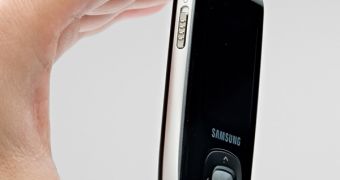
 14 DAY TRIAL //
14 DAY TRIAL // 